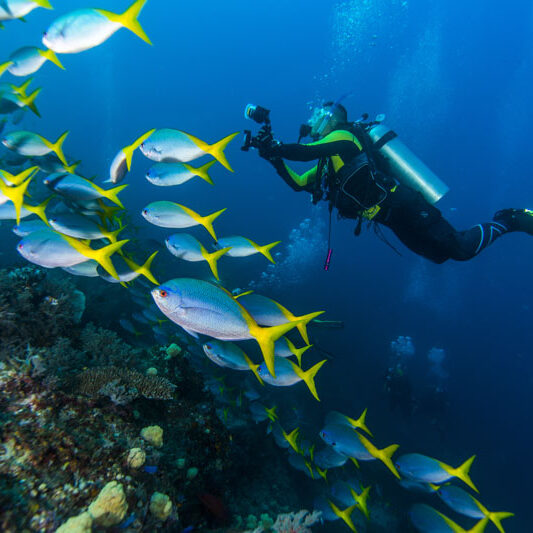Key Largo was one of the first areas in the world to dive into the conservation of its marine habitat. John Pennekamp Coral Reef Park was founded in 1960 and the Key Largo National Marine Sanctuary was created in 1975. As a result, the reef has been protected for more than four decades. And in the mid-1990s, the entire island chain was given additional protection as the Florida Keys National Marine Sanctuary.
This designation has provided a uniquely rich coral environment where the 600 species of tropical fish are numerous and friendly - a veritable paradise for diver and snorkeler.
Key Largo is best known for its shallow reefs and deep wrecks. The shallow reefs provide world class diving for scuba divers of all ages and skills. The deep wrecks offer some of the best wreck diving found anywhere.

Here are some of Key Largo’s most popular spots:
The Elbow is a reef system where you can find several historic shipwrecks; the City of Washington is one of them. Visibility is also good here due to the proximity of the Gulf Stream. Residents include several friendly nurse sharks and moray eels.
Key Largo Dry Rocks is the site of the famous "Christ of the Deep" Statue; this is one of the Keys' most popular diving and snorkeling locations. Key Largo Dry Rocks, is a shallow site, and offers close viewing of many types of fish.
North Dry Rocks is just north of Key Largo Dry Rocks. A shallow location, this reef contains the popular "Minnow Cave" - known for it's large seasonal population of silverside minnows.
North North Dry Rocks is just north of North Dry Rocks. A shallow spur and grove reef with some of the healthiest coral in the area.
The wreck of the Benwood is a shallow wreck found between French Reef and the Spiegel Grove sight. The Benwood is an old Norwegian freighter that has been down since 1942. The abundance of marine life and easy navigation makes it a popular night dive.
French Reef is known for its swim throughs and coral caves. It offers the chance to observe many species of fish and reef creatures, many of which never leave the shelter of the coral caves and tunnels. French Reef also has large formations of elk horn and stag horn corals.
Molasses Reef is said to be the most popular dive destination in the world. It’s great for snorkelers and divers alike as the reef touches the surface in places and slopes down to a depth of about fifty-five feet. The gulf stream provides for some of the best visibility in the area. The population of reef creatures is always changing, and includes frequent visits by many different pelagic species.
The USCG Cutters Duane and Bibb were intentionally sunk in 1987 to form an artificial reef only a mile south of Molasses Reef. Both lie in 130 feet of water. The Duane stands upright with its crow’s nest sixty feet below the surface; the Bibb lies on its starboard side. Visibility is great here, but the currents can be very challenging. These are not novice dives but well within the abilities of the accomplished recreational scuba diver.
USS Spiegel Grove is Key Largo's newest wreck. This 510 ft. landing ship dock is the second largest ship ever sunk as an artificial reef. She went down May 17, 2002, and settled on her starboard side in 130 ft of water. Thanks to a combination of current and Hurricane Dennis, the Grove righted herself in 2005. Her keel now sits on the bottom - almost perfectly horizontal from bow to stern. Visibility is great here, but the currents can be challenging. Again, this is not a novice dive but well within the abilities of the accomplished recreational scuba diver.



